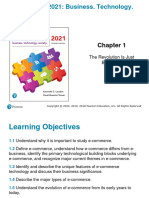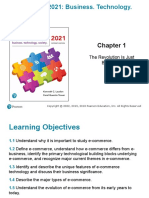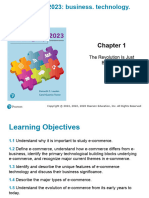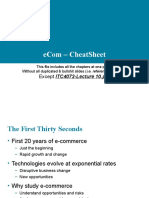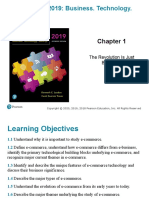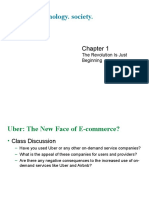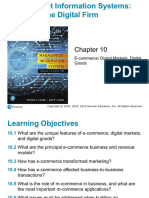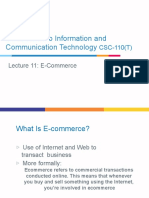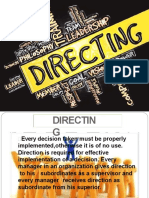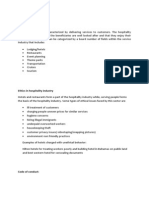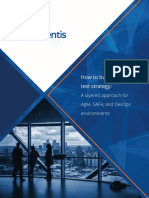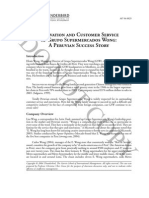E-commerce 2023: business. technology.
society.
Seventeenth Edition
Chapter 1
The Revolution Is Just
Beginning
Copyright © 2024, 2022, 2020 Pearson Education, Inc. All Rights Reserved
�Learning Objectives
1.1 Understand why it is important to study e-commerce.
1.2 Define e-commerce, understand how e-commerce differs from e-
business, identify the primary technological building blocks underlying
e-commerce, and recognize major current themes in e-commerce.
1.3 Identify and describe the unique features of e-commerce
technology and discuss their business significance.
1.4 Describe the major types of e-commerce.
1.5 Understand the evolution of e-commerce from its early years to
today.
1.6 Describe the major themes underlying the study of e-commerce.
Copyright © 2024, 2022, 2020 Pearson Education, Inc. All Rights Reserved
�ECOMMERCE CASE
Copyright © 2024, 2022, 2020 Pearson Education, Inc. All Rights Reserved
�Youtube: Creators and the Creator
Economy
• Class Discussion
– Why is Youtube so popular?
– Do you use Youtube? If so, in what manner—do you
just view content or also post content?
– Do you consider yourself a creator? Have you ever
received payments for content you have created?
– What are some of the negative consequences
associated with being a creator?
Copyright © 2024, 2022, 2020 Pearson Education, Inc. All Rights Reserved
�Everything on Demand
• Uber is a poster child for “digital disruption.”
• Uber’s business model is also much more efficient than a
traditional taxi firm.
– Uber does not own taxis and has no maintenance and
financing costs.
– Uber calls its drivers “independent contractors,” not
employees.
– Doing so enables Uber to avoid costs for workers’
compensation, minimum wage requirements, driver
training, health insurance, and commercial licensing.
• Uberization of work (gig economy)
Copyright © 2024, 2022, 2020 Pearson Education, Inc. All Rights Reserved
�The First Five Minutes: Why You Should
Study E-commerce
• First quarter-century or so of e-commerce
– Still just the beginning
– Rapid growth and change
• Technologies evolve at exponential rates
– Disruptive business change
– New opportunities
• Why study e-commerce
– Understand opportunities and risks
– Analyze e-commerce ideas, models, issues
Copyright © 2024, 2022, 2020 Pearson Education, Inc. All Rights Reserved
�What Is E-commerce?
• Use of Internet to transact business
– Includes Web, mobile browsers and apps
– Internet vs. Web
• More formally:
– Digitally enabled commercial transactions between
and among organizations and individuals
– An exchange of value occurs
Copyright © 2024, 2022, 2020 Pearson Education, Inc. All Rights Reserved
�The Difference Between E-commerce and
E-business
• E-business
– Digital enabling of transactions and processes within
a firm, involving information systems under firm’s
control
– Does not include commercial transactions involving
an exchange of value across organizational
boundaries
Copyright © 2024, 2022, 2020 Pearson Education, Inc. All Rights Reserved
�Figure 1.1 The Difference Between
E-commerce and E-business
Copyright © 2024, 2022, 2020 Pearson Education, Inc. All Rights Reserved
�Technological Building Blocks
Underlying E-commerce
• The Internet
– Worldwide network of computer networks built on
common standards
• The World Wide Web
– Provides access to trillions of web pages created in
HTML
– “Surface” Web versus “deep” Web
• Mobile platform
– Smartphones, tablets, ultra-lightweight laptops
– Mobile apps
Copyright © 2024, 2022, 2020 Pearson Education, Inc. All Rights Reserved
�Copyright © 2024, 2022, 2020 Pearson Education, Inc. All Rights Reserved
�Technological Building Blocks
Underlying E-commerce
• https://amela.vn/phan-biet-native-app-web-app-hybrid-a
pp-nen-su-dung-app-nao/
• https://baseus.vn/blogs/news/su-khac-biet-giua-deep-w
eb-va-dark-web-la-gi
• https://viettelidc.com.vn/tin-tuc/html-la-gi-nguyen-ly-
hoat-dong-cua-html
Copyright © 2024, 2022, 2020 Pearson Education, Inc. All Rights Reserved
�Copyright © 2024, 2022, 2020 Pearson Education, Inc. All Rights Reserved
�Insight on Technology: Will Apps Make
the Web Irrelevant?
• Class Discussion
– What are the advantages and disadvantages of
apps, compared with websites, for mobile users?
– What are the benefits of apps for content owners
and creators?
– What are progressive web apps and how do they
differ from native apps?
– Will apps eventually make the Web irrelevant?
Why or why not?
Copyright © 2024, 2022, 2020 Pearson Education, Inc. All Rights Reserved
�Major Trends in E-commerce (1 of 3)
• Business trends include:
– Retail e-commerce and m-commerce settle back to
normal growth rates (around 10%) after Covid-19
pandemic
– Mobile app ecosystem: almost 250 million U.S. adults
use smartphone apps
– Social e-commerce estimated to generate around $55
billion in 2022
– B2B e-commerce revenues expected to reach about
$8.5 trillion in 2022
Copyright © 2024, 2022, 2020 Pearson Education, Inc. All Rights Reserved
�Major Trends in E-commerce (2 of 3)
• Technology trends include:
– Mobile platform
– Cloud computing
– Internet of Things
– Big data
– Artificial intelligence technologies
– Blockchain
– Web3
– Metaverse
Copyright © 2024, 2022, 2020 Pearson Education, Inc. All Rights Reserved
�Major Trends in E-commerce (3 of 3)
• Societal trends include:
– User-generated content
– Commercial and governmental invasion of privacy
– Concerns about increasing market dominance of
Amazon, Google, Meta (Big Tech)
– Online security issues
Copyright © 2024, 2022, 2020 Pearson Education, Inc. All Rights Reserved
�Revenue of ecommerce platform
report 2024
Copyright © 2024, 2022, 2020 Pearson Education, Inc. All Rights Reserved
�Unique Features of E-commerce
Technology (1 of 2)
1. Ubiquity
– marketplace → marketspace
– reduce transaction cost (travel time and effort)
– lessen cognitive energy
2. Global reach
3. Universal standards
– television and radio standards differ around the world
– network externalities
4. Information richness
Copyright © 2024, 2022, 2020 Pearson Education, Inc. All Rights Reserved
�Unique Features of E-commerce
Technology (2 of 2)
5. Interactivity
– Traditional television or radio, for instance, cannot ask viewers questions or
enter into conversations with them, or request that customer information be
entered into a form.
6. Information density
– the total amount and quality of information available to all market
participants
– Price transparency, cost transparency, price discrimination
7. Personalization/customization
– information about the consumer’s past purchases and behavior can be
stored and used by online merchants
8. Social technology
Copyright © 2024, 2022, 2020 Pearson Education, Inc. All Rights Reserved
�Copyright © 2024, 2022, 2020 Pearson Education, Inc. All Rights Reserved
�Figure 1.4 Eight Unique Features of
E-commerce Technology
Copyright © 2024, 2022, 2020 Pearson Education, Inc. All Rights Reserved
�Types of E-commerce
• Mobile e-commerce (M-commerce)
– conversational commerce involves the use of chatbots on
mobile messaging apps
• Social e-commerce
– Live Streaming
– Virtual shop
– Ratings and recommendations
• Local e-commerce
– local on-demand services such as Uber, AirBnB
Copyright © 2024, 2022, 2020 Pearson Education, Inc. All Rights Reserved
�Figure 1.9 The Relative Size of Different
Types of E-commerce
Copyright © 2024, 2022, 2020 Pearson Education, Inc. All Rights Reserved
�E-commerce: A Brief History (1 of 4)
• Precursors
– Baxter Healthcare modem-based system (1970s)
– Order entry systems (1980s)
– Electronic Data Interchange (EDI) standards (1980s)
– French Minitel (1981)
Copyright © 2024, 2022, 2020 Pearson Education, Inc. All Rights Reserved
�E-commerce: A Brief History (2 of 4)
• 1995–2000: Invention
– Sale of simple retail goods
– Limited bandwidth and media
– Euphoric visions of:
▪ Technologists celebrated the fact that the Internet was not controlled by
anyone or any nation but was free to all.
▪ For economists, the early years of e-commerce raised the realistic prospect
of a nearly perfect competitive market
▪ disintermediation
▪ Friction-free commerce
– First-mover advantages
▪ building in switching costs for their customers through proprietary interface
designs and features available only on one platform
▪ network effect
– Dot-com crash of 2000
Copyright © 2024, 2022, 2020 Pearson Education, Inc. All Rights Reserved
�E-commerce: A Brief History (3 of 4)
• 2001–2006: Consolidation
– Emphasis on business-driven approach (vs.
technology driven)
– Traditional large firms expand presence
– Start-up financing shrinks
– More complex products and services sold (travel and
finance)
– Growth of search engine advertising
– Business web presences expand
Copyright © 2024, 2022, 2020 Pearson Education, Inc. All Rights Reserved
�E-commerce: A Brief History (4 of 4)
• 2007–Present: Reinvention
– Rapid growth of:
▪ Web 2.0, including online social networks
▪ Mobile platform
▪ Local commerce
▪ On-demand service economy
– Entertainment content develops as source of
revenues
– Transformation of marketing
Copyright © 2024, 2022, 2020 Pearson Education, Inc. All Rights Reserved
�Copyright © 2024, 2022, 2020 Pearson Education, Inc. All Rights Reserved
�Figure 1.10 Periods in the Development
of E-commerce
Copyright © 2024, 2022, 2020 Pearson Education, Inc. All Rights Reserved
�Insight on Business: Y Combinator’s
Startup Boot Camp
• Class Discussion
– Why do you think investors today are still interested
in investing in startups?
– What are the benefits of investing in a company that
is a graduate of a Y Combinator boot camp?
– Is an incubator the best solution for startups to find
funding? Why or why not?
Copyright © 2024, 2022, 2020 Pearson Education, Inc. All Rights Reserved
�Assessing E-commerce (1 of 2)
• Stunning technological success
• Early years a mixed business success
– Few early dot-coms have survived
– Online sales growing rapidly
• Many early visions not fulfilled
– Price dispersion
– Information asymmetry, e.g., flash pricing
– New intermediaries, e.g., expedia, agoda, etc.
Copyright © 2024, 2022, 2020 Pearson Education, Inc. All Rights Reserved
�Assessing E-commerce (2 of 2)
• Other surprises
– Fast-follower advantages
– Start-up costs
– Impact of mobile platform
– Emergence of on-demand e-commerce
Copyright © 2024, 2022, 2020 Pearson Education, Inc. All Rights Reserved
�Understanding E-commerce:
Organizing Themes
• Technology
– Development and mastery of digital computing and
communications technology
• Business
– New technologies present businesses with new ways
of organizing production and transacting business
• Society
– Intellectual property, individual privacy, public welfare
policy
Copyright © 2024, 2022, 2020 Pearson Education, Inc. All Rights Reserved
�Copyright © 2024, 2022, 2020 Pearson Education, Inc. All Rights Reserved
�Insight on Society: Facebook and the
Age of Privacy
• Class Discussion
– Why are social networks interested in collecting user
information?
– What types of privacy invasion are associated with
Facebook?
– How do you protect your privacy online?
– https://www.thehindubusinessline.com/info-tech/indian
-women-ditching-facebook-due-to-safety-privacy-conc
erns-study/article65666502.ece
Copyright © 2024, 2022, 2020 Pearson Education, Inc. All Rights Reserved
�Careers in E-commerce
• Position: Category Specialist in the E-commerce Retail
Program
• Qualification/Skills
• Preparing for the Interview
• Possible Interview Questions
Copyright © 2024, 2022, 2020 Pearson Education, Inc. All Rights Reserved
� This work is protected by United States
Copyright
copyright laws and is provided solely for
the use of instructors in teaching their
courses and assessing student learning.
Dissemination or sale of any part of this
work (including on the World Wide Web)
will destroy the integrity of the work and is
not permitted. The work and materials from
it should never be made available to
students except by instructors using the
accompanying text in their classes. All
recipients of this work are expected to
abide by these restrictions and to honor the
intended pedagogical purposes and the
needs of other instructors who rely on
these materials.
Copyright © 2024, 2022, 2020 Pearson Education, Inc. All Rights Reserved




